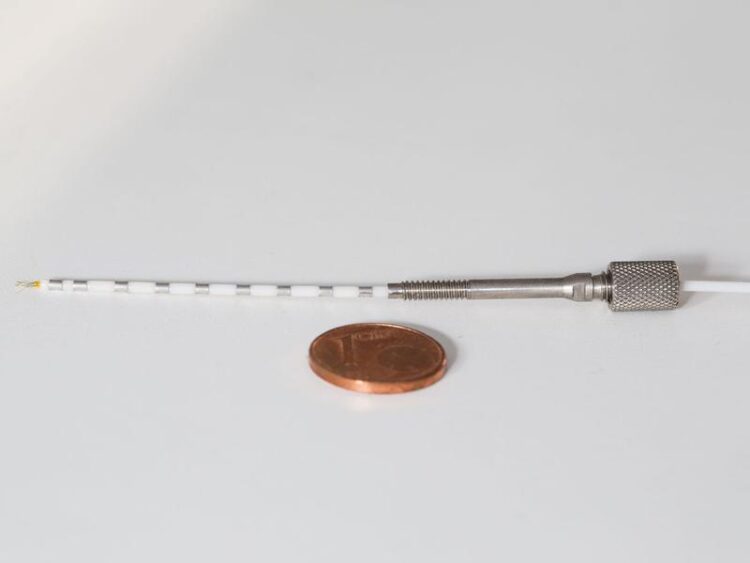Nerve cell activity shows how confident we are

Ultra-fine electrodes implanted in the temporal lobes of epileptic patients enable researchers to visualize the activity of individual nerve cells.
© Christian Burkert
Should I or shouldn’t I? The activity of individual nerve cells in the brain tells us how confident we are in our decisions. This is shown by a recent study by researchers at the University of Bonn. The result is unexpected – the researchers were actually on the trail of a completely different evaluation mechanism. The results are published in the journal Current Biology.
You are sitting in a café and want to enjoy a piece of cake with your cappuccino. The Black Forest gateau is just too rich for you and is therefore quickly eliminated. Choosing between the carrot cake and the rhubarb crumble is much trickier: The warm weather favors the refreshingly fruity cake. Carrot cake, however, is one of your all-time favorites. So what to do?
Every day we have to make decisions, and we are much more confident about some of them than others. Researchers at the University Hospital Bonn have now identified nerve cells in the brain whose activity indicates the confidence in decisions. A total of twelve men and women took part in their experiment.
“We showed them photos of two different snacks, for example a chocolate bar and a bag of chips,” explains Prof. Dr. Dr. Florian Mormann from the Department of Epileptology. “They were then asked to use a slider to indicate which of these alternatives they would rather eat.” The more they moved the slider from its center position towards the left or right photo, the more confident they were in their decision.
Fire rate and confidence are related
Participants had to judge a total of 190 different snack pairs in this way. At the same time, the scientists recorded the activity of 830 nerve cells each in the so-called temporal lobe. “We discovered that the frequency of the electrical pulses in some neurons, in other words their ‘firing rate’, changed with increasing decision confidence,” explains Mormann’s colleague Alexander Unruh-Pinheiro. “For instance, some fired more frequently, the more confident the respective test person was in their decision.”
It is the first time that such a correlation between activity and decision confidence has been identified. The affected neurons are located in a brain region that plays a role in memory processes. “It is possible that we not only store what decision we made, but also how confident we were in it,” speculates Mormann. “Perhaps such a learning process saves us from future wrong decisions.”
Ethical reasons usually prohibit the study of the state of individual neurons in living humans. However, the participants in the study suffered from a severe form of epilepsy. In this form of the disease, the characteristic seizures always start in the same area of the brain. One possible treatment is therefore to remove this epileptic focus surgically. To pinpoint the exact location of the defective site, the doctors at the Clinic for Epileptology implant several electrodes in the patient. These are distributed over the entire potentially affected area. At the same time, they also allow an insight into the functioning of individual nerve cells in the brain.
Researchers at the University of Bonn were originally looking for a completely different phenomenon: When we make a decision, we assign a subjective value to each of the alternatives. “There is evidence that this subjective value is also reflected in the activity of individual neurons,” says Mormann. “The fact that we instead came across this connection between fire behavior and decision confidence surprised even us.”
Wissenschaftliche Ansprechpartner:
Prof. Dr. Dr. Florian Mormann
Klinik für Epileptologie
Universitätsklinikum Bonn
Tel. 0228/28715738
E-mail: florian.mormann@ukbonn.de
Originalpublikation:
Alexander Unruh-Pinheiro, Michael R. Hill, Bernd Weber, Jan Boström, Christian E. Elger, Florian Mormann: Single Neuron Correlates of Decision Confidence in the Human Medial Temporal Lobe. Current Biology; dx.doi.org/10.1016/j.cub.2020.09.021
Media Contact
All latest news from the category: Medical Engineering
The development of medical equipment, products and technical procedures is characterized by high research and development costs in a variety of fields related to the study of human medicine.
innovations-report provides informative and stimulating reports and articles on topics ranging from imaging processes, cell and tissue techniques, optical techniques, implants, orthopedic aids, clinical and medical office equipment, dialysis systems and x-ray/radiation monitoring devices to endoscopy, ultrasound, surgical techniques, and dental materials.
Newest articles

Innovative 3D printed scaffolds offer new hope for bone healing
Researchers at the Institute for Bioengineering of Catalonia have developed novel 3D printed PLA-CaP scaffolds that promote blood vessel formation, ensuring better healing and regeneration of bone tissue. Bone is…

The surprising role of gut infection in Alzheimer’s disease
ASU- and Banner Alzheimer’s Institute-led study implicates link between a common virus and the disease, which travels from the gut to the brain and may be a target for antiviral…

Molecular gardening: New enzymes discovered for protein modification pruning
How deubiquitinases USP53 and USP54 cleave long polyubiquitin chains and how the former is linked to liver disease in children. Deubiquitinases (DUBs) are enzymes used by cells to trim protein…



